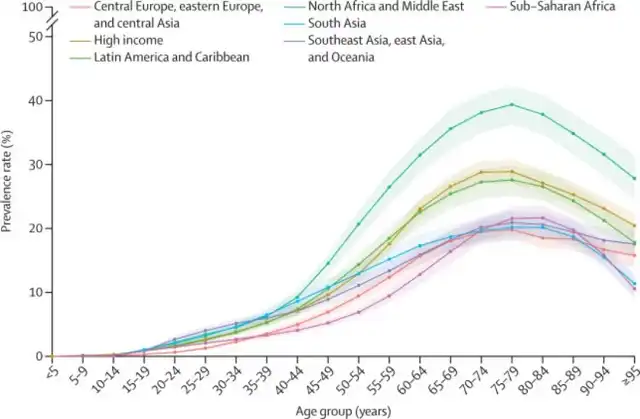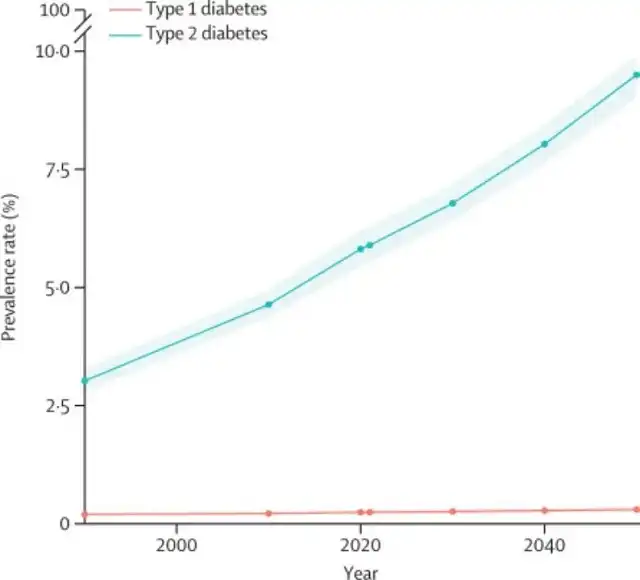The Lancet: People with Diabetes may exceed 1.3 billion by 2050
- Normal Liver Cells Found to Promote Cancer Metastasis to the Liver
- Nearly 80% Complete Remission: Breakthrough in ADC Anti-Tumor Treatment
- Vaccination Against Common Diseases May Prevent Dementia!
- New Alzheimer’s Disease (AD) Diagnosis and Staging Criteria
- Breakthrough in Alzheimer’s Disease: New Nasal Spray Halts Cognitive Decline by Targeting Toxic Protein
- Can the Tap Water at the Paris Olympics be Drunk Directly?
The Lancet: People with Diabetes may exceed 1.3 billion by 2050
- Should China be held legally responsible for the US’s $18 trillion COVID losses?
- CT Radiation Exposure Linked to Blood Cancer in Children and Adolescents
- FDA has mandated a top-level black box warning for all marketed CAR-T therapies
- Can people with high blood pressure eat peanuts?
- What is the difference between dopamine and dobutamine?
- How long can the patient live after heart stent surgery?
The Lancet: People with Diabetes may exceed 1.3 billion by 2050.
Diabetes is a chronic disease that affects more than 540 million people worldwide and is one of the leading causes of death and disability worldwide.
With the changes in living and eating habits, diabetes has become the third major factor affecting human health after cardiovascular and cerebrovascular diseases and malignant tumors, bringing heavy physical and mental burdens to individuals and families.
On June 22, 2023, The Lancet published a research paper titled “Global, regional, and national burden of diabetes from 1990 to 2021, with projections of prevalence to 2050: a systematic analysis for the Global Burden of Disease Study 2021.”
The study was conducted by researchers from the Institute for Health Metrics and Evaluation (IHME) at the University of Washington School of Medicine in the United States.
They used the latest evidence and analytical framework from the Global Burden of Disease Study (GBD) to estimate the prevalence and burden of diabetes from 1990 to 2021, specific to geographical locations, age groups, and genders.
Additionally, they estimated the proportions of type 1 and type 2 diabetes in 2021, the proportion of the burden of type 2 diabetes attributed to selected risk factors, and predicted the prevalence of diabetes until 2050.
Diabetes Overview
Diabetes mellitus is a serious chronic disease characterized by elevated blood glucose concentrations associated with the impact of abnormal beta-cell biology on insulin action.
Diabetes occurs when the pancreas does not produce enough insulin or the body cannot effectively use the insulin it produces. Diabetes is the eighth leading cause of death and disability worldwide and a leading cause of ischemic heart disease, blindness, kidney failure, stroke and lower limb amputations.
The most common forms of diabetes are type 1 and type 2 diabetes. Type 1 diabetes (once called insulin-dependent diabetes or juvenile-onset diabetes) is characterized by insufficient insulin secretion and requires daily infusions of insulin, and its etiology is unknown.
More than 95 percent of people with diabetes have type 2 diabetes (formerly known as non-insulin-dependent diabetes or adult-onset diabetes) , which is characterized by abnormalities in the body’s use of insulin, which affects how the body uses glucose for energy. Causes include obesity , lack of exercise, and genetics.
Diabetes Prevalence Assessment
In 2021 , there will be about 529 million diabetic patients of all ages in the world, and the global age-standardized prevalence rate is about 6.1%. Researchers estimate that there will be about 485 million diabetic patients aged 20 to 79, of which 43 countries and regions aged The standardized prevalence of diabetes was over 10%.
From the perspective of different genders, in 140 (68.6%) countries, the incidence of diabetes in men is higher than that in women, with the incidence rate of 6.5% in men and 5.8% in women.
From the perspective of different ages, the total prevalence of diabetes in the age group under 20 years old is less than 1%; the total prevalence of diabetes is particularly obvious in the population aged 65 and above, with an incidence rate of more than 20%; the global prevalence of diabetes It peaked at 24.4% between the ages of 75-79.

Globally, DALYs (disability-adjusted life years) caused by diabetes are 79.2 million. In China, the number of DALYs due to diabetes is 11.7 million in 2021 , and the change rate of DALYs from 1990 to 2021 is 172.9%.
From the perspective of disease type, in all 204 countries and regions, type 2 diabetes cases accounted for more than 80% of all diabetes cases, and in 183 countries and regions with more than 89.7%, the prevalence of type 2 diabetes accounted for 96%.
From the perspective of risk factors, 76.5% of DALYs (disability-adjusted life years) caused by type 2 diabetes can be attributed to risk factors, obesity (high BMI ) is the main risk factor, accounting for 52.2% of type 2 diabetes DALYs , followed by diet (25.7%), environmental or occupational risks (19.6%), smoking (12.1%), lack of exercise (7.4%), and alcohol consumption (1.8%).
From 1990 to 2021, the proportion of DALYs caused by high BMI increased in every country and region in the world, from 42.2% in 1990 to 52.2% in 2021.
Diabetes Prevalence Changes, 1990-2021, and Predictions to 2050
Between 1990 and 2021, the global age-standardized diabetes prevalence increased by 90.5%, from 3.2% to 6.1%. In 97 of the 100 countries (47.5%) the age-standardized prevalence of diabetes increased by more than 204%.
From 2021 to 2050, the global age-standardized total prevalence of diabetes is expected to increase by 59.7%, from 6.1% to 9.8%, and 1.31 billion people will have diabetes by 2050, with an annualized rate of change of 3.31%. Of this increase, 49.6 percent was driven by obesity trends and the remaining 50.4 percent was driven by demographic changes.

The increase in the overall prevalence of diabetes is expected to be primarily driven by the increase in type 2 diabetes. The global age-standardized prevalence of type 2 diabetes is projected to increase by 61.2%, from 5.9% in 2021 to 9.5% in 2050, affecting more than 1.27 billion people. The global age-standardized prevalence of type 1 diabetes is projected to increase by 23.9%, from 0.2% in 2021 to 0.3% in 2050.
Diabetes Treatment and Prevention
Type 1 diabetes is treated with insulin injections. The majority of diabetic patients are obesity-induced patients, that is, type 2 diabetes patients.
Type 2 diabetes mainly uses hypoglycemic drugs to control blood sugar, and often requires lifelong medication, such as metformin, sulfonylureas, or sodium-glucose cotransporter type 2 (SGLT-2) inhibitors, etc., if the islet function is reduced or insulin If the secretion is too low, insulin injection therapy also needs to be considered.
Non-drug-assisted treatment of type 2 diabetes is mainly diet control and exercise. Most type 2 diabetes is caused by obesity.
Obese people have abnormal fat distribution and excessive accumulation, which will lead to insulin resistance and overload the pancreas.
Weight loss can be used to regulate lipid metabolism, thereby affecting glucose metabolism and repairing lipid metabolism to achieve balance The purpose of glucose metabolism.
For ordinary people, if you want to prevent diabetes, you must first monitor your blood sugar regularly and have regular physical examinations; in addition, you must maintain a healthy diet and reduce your sugar intake.
Do some aerobic exercise properly; of course, the most important thing is to maintain a healthy weight, and eliminating obesity is the most effective measure to treat and prevent diabetes .
Epilogue
The continuous and rising prevalence of diabetes has posed a huge public health challenge worldwide, and governments and public health authorities around the world are increasingly concerned about the soaring prevalence of diabetes among people and its impact on healthcare systems and society .
At the current rate of prevalence, it is estimated that more than 1.31 billion people will suffer from diabetes by 2050 , most of whom will be type 2 diabetics.
Addressing the escalating challenges of diabetes prevention and the barriers to managing diabetes and its complications will become an essential part of healthcare delivery globally.
There is an urgent need to address the unfavorable trends in the prevalence of type 2 diabetes risk factors, especially obesity.
If new and more effective countermeasures are not taken, diabetes will continue to have increasingly serious negative impacts on the quality of life of individuals, population health and social productive activities in the coming decades.
References:
[1] GBD 2021 Diabetes Collaborators. Global, regional, and national burden of diabetes from 1990 to 2021, with projections of prevalence to 2050: a systematic analysis for the Global Burden of Disease Study 2021. Lancet. 2023 Jun 22:S0 140-6736 (23)01301-6. doi: 10.1016/S0140-6736(23)01301-6.
(source:internet, reference only)
Disclaimer of medicaltrend.org
Important Note: The information provided is for informational purposes only and should not be considered as medical advice.



